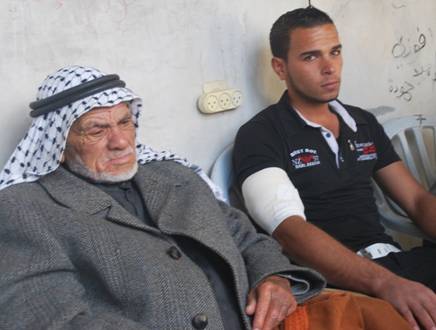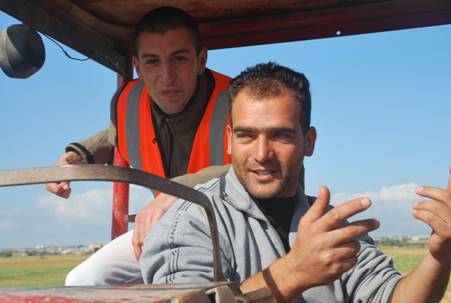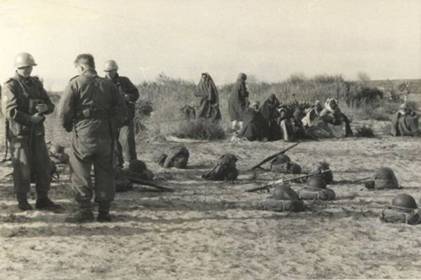The Struggle For Land Rights Near The Gaza Border
By Joshua Brollier
15 December , 2012
Countercurrents.org
Gaza City-Yesterday in al-Faraheen, Gaza , Israeli Occupation Forces shot and wounded an unarmed 22 year oldfarmer, Mohammed Qdeih, from behind. Mohamed and nine others went out to their fields in the early afternoon, walking approximately 250 meters from the Israeli border. Within minutes, two heavily armed Israeli military jeeps rushed to the security fence. They issued a warning for the farmers and residents to leave the area and shortly thereafter the Palestinians, intimidated by the heavy military presence, began to head back tothe village of Abasan . The soldiers were not satisfied and opened fire, piercing Mohamed's right arm from the backside. Israeli forces continued to shoot rounds of live ammunition while Mohamed and the others frantically evacuated and waited for an ambulance. Another young Palestinian, 19, was shot yesterday near the border in Jabaliya.

Under the siege, Israeli “closed military zones” have confiscated up to 35 per cent of Gaza 's arable land, which was previously used for fruit and olive orchards, wheat and various vegetables. With nearly half of Gaza 's population designated as “food insecure” by UN Office for the Coordination of Humanitarian Affairs (OCHA) and the farming industry having been crippled from the inability to export products under the Israeli blockade, this land is essential for the livelihoods of thousands of farmers and residents of Gaza . Even so and given that four Palestinians have been killed and over 50 injured since the November 21st,2012 ceasefire agreement, one might ask why anyone would risk their life and venture near the border at all.
Palestinians have had varying experiences near the fence. There have been some successes with farming and some incidents resulting in death and seriousinjuries.The agreement between Israel and Hamas clearlystated that Israeli forces would “refrain from targeting residents in the border areas” and to “stop all hostilities in the Gaza Strip land, sea and air including incursions and targeting of individuals.”Hamas and other factions have held up their end of the bargain with not a single rocket being fired from Gaza ,
As a participant in an international solidarity team , I sat down this with Mohammed Qdeih and family membersthis afternoon to get their perspective on the breach of the ceasefire and why they would risk their lives in pursuit of reclaiming their land. “The ceasefire is without any sense,” said Mohammed. “They attempted to kill me.” Mohammed is single but works the land to help provide for his 15 extended family members who reside together in Abasan al-Kabir. The family has approximately ten dunams of land which fall in the vaguely defined “buffer zone.” He is one of only five who are able to work in the fields and now the family will be without his help for a month at best.

After waiting patiently for Mohammed to tell his story, attention shifted to the eldest member of the family, Ahmed Hassan JabbarQdeih. Around ninety five years old, Ahmed became infuriated and began to speak up passionately. “What I have seen in my lifetime is too much tobare!” Though they are originally from Abasan, the Qdeihfamily used to have 500 dunams of land which spread far beyond Gaza 's borders, most of which fell in what is now considered Israel . In 1948when Ahmed was in his thirties, he was working near the local water well when Zionist militias terrorized his farm. Ahmed was detained, along with his family, and taken to their house where they were forced to watch as his father was murdered in front on them. The militias destroyed their home, bombed the well and set ablaze 60 dunams of land. Additionally, they stole 60 sheep and two cows to takewith them.
Mr.Qdeih also spoke of February 7 th , 1957 . Just before Israel withdrew from the Gaza Strip in March of that year (under very strong pressure from the United States ),Ahmed again barely escaped with his life. Presumably during one of Israel 's last “screening operations” to eliminate members of the Palestine Brigades in which over 500 Palestinians were killed, Israeli forces lined up Ahmed and ten other men who were then mowed down with gunfire and executed. The rifle which targeted Ahmed malfunctioned. When he was later discovered to still be alive, he was arrested and imprisoned in Israel for eight years. While in jail, the prison guards stomped on his hands and beat him mercilessly, leaving him permanently disabled and unable to walk properly. In the process of explaining this, Ahmed almost removed his shirt successfully in front of all present before being discouraged by a relative standing nearby. “Look, look! You can still see the scars on my back,” he nearly screamed in a fashion as if he was still reliving those torturous years.

Having a proud persistence in farming and a history of tragedy dating back to the Nakba, the connection to the land runs deep for the Qdeihs andobviously so do the scars. As many Palestinians feel that they have taken the victory from the recent conflict, the presentsituation holdsmany possibilitiesfarmers like the Qdeih family. Though recent events have been no less distressing. Twodays after the Israeli Pillar of Cloud offensive, Anwar Qdeih, the twenty year old cousin of Mohamed Qdeih, was shot and killed while participating in an impromptu demonstration near the border.
In a celebratory mood due to the gains supposedly guaranteed by the ceasefire and in defiance of the brutality of the recent Israeli assault, a small group consisting primarily of young men headed to the “buffer zone.”When approached by heavily-armed Israeli soldiers, some threw stones and managed to cross the first security fence, which does not constitute the official border. Upon confrontation with the soldiers, the group turned back and the Israeli forces opened fire striking Anwar in the head and killing him instantly. Eighteen others were wounded, including three children. (There is also a second fence the protesters did not reach which is electrically charged, more heavily guarded and virtually impenetrable to such a group. There are no Israeli houses or civilians in the vicinity. It is also essential to remember that Palestinians have a legal right to resist the occupation through such demonstrations and even armed resistance.)
The Israeli military establishment seemsto be confounded that, for all its advanced weaponry and fire power,hundreds of young men like Anwar and Mohammedand elders like Ahmed continue to come out daily to their fields. The right-wing, ruling elite and even many self-proclaimed “liberals” inIsrael appear to be in denial that the Palestinians' claim to their land and will for self-determination is unquenchable. While they talk of more deadly operations like Cast Lead and Pillar of Cloud, they continue with the harassment of farmers and fishermen. While they provide for and forcefully protect more illegal settlements and carry out the demolitions of Palestinian homes in the West Bank , they justify the killing of a young man at a check point in Hebron and the following vicious assaults on the media. While strengthening apartheid policies against Arab and non-Jewish Israelis and fortifying new stretches of the separation wall, they feel the need to collectively punish the civilian population of Gaza with siege. While they aggressivelystomp any remnants of a two-state solution under their feet and isolate themselves with mantras of victimhood, the United Nations has affirmed the right to Palestinian statehood.
What are the goals and likely consequences of these violent and obstructionist policies? How could they possibly make Israel more secure or lead to a just solution? All the while, resistance is again becoming more and more popularized among Palestinian civilians and the factions are moving towards uniting. Regardless of the new shapes the resistance takes or any path the Israelis choose, as evidenced clearly since 1948 until this very day,the Palestinians'deep connection to and affection for their homeland cannot be broken.
Joshua Brollier is a co-coordinator with Voices for Creative Nonviolence . He can be reached at [email protected].
Links:
1. http://www.ochaopt.org/documents/ocha_opt_gaza_blockade_factsheet_june_2012_english.pdf
2. http://www.imemc.org/article/64748
3. http://vcnv.org/israeli-forces-fire-on-gaza-farmers-and-internationals-in-khuza-a
6. http://en.wikipedia.org/wiki/Israel_and_Egypt_%E2%80%93_Gaza_Strip_barrier
7. http://www.jadaliyya.com/pages/index/8807/is-gaza-still-occupied-and-why-does-it-matter
8. http://972mag.com/why-was-17-years-old-muhammad-killed/61950/
Comments are moderated


